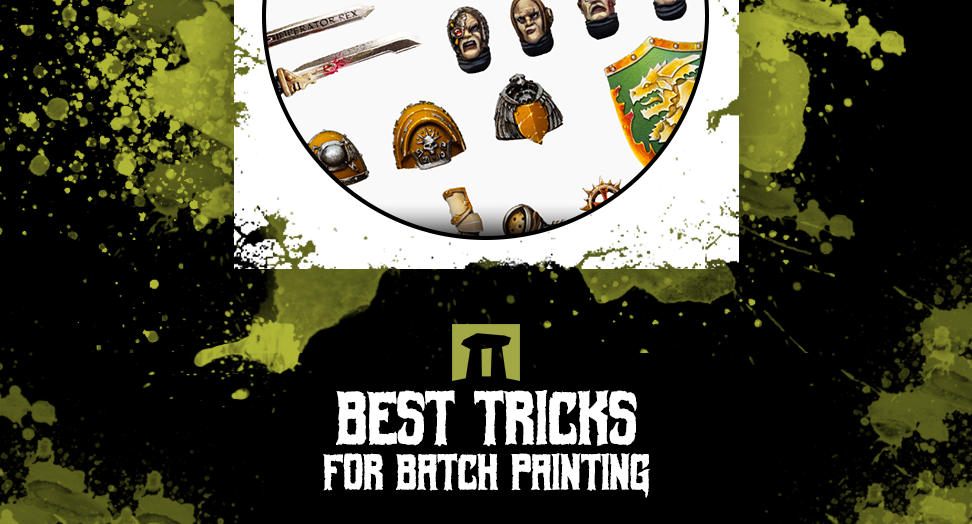Best tricks for batch painting

In every painter or modeler’s career, he had many models to cover in paint, but he didn’t have enough time (or strength) to do so. Let’s be honest - painting is a great artistic activity and brings highly-visible and automatically-noticeable effects, but it’s also time-consuming.
It’s an especially true statement if we want to do it right - and by right, we don’t necessarily mean high, tournament level. Probably, we all can agree on a painting style that is usually called “tabletop.” It means that the miniatures don’t need to be painted so they look like works of art, but they have to be painted neatly and elegantly - so they look representatively on the wargaming table.
Is it possible to paint like that in a relatively short time? How to do so when you wish to paint numerous miniatures at once? Keep reading if you want to learn the best tricks for batch painting!
Choose colors that complement each other
Here, at Kromlech - among gaming accessories, the terrain made by Tabletop Scenics, and more - we might have few paints in our offer, but in our modeling and basing category, you can find Dirty Down Paints. Nonetheless, the fact that we focus on producing tokens, markers, templates, and similar doesn’t mean we don’t know anything about painting.
Assume you want to batch paint your Space Marines miniatures for Warhammer 40k by Games Workshop. The first thing you should consider is choosing the right colors. In case when you paint one of the known Chapters, such as Ultramarines, you’ll have fewer options, no doubt about it. On the other hand, if you wish to create an army for your invented Chapter, you might think about this subject during the step of planning the Chapter’s colors.
Pick colors that complement each other. Thanks to that move, you’ll be able to paint your figures faster, as the areas where two differently-colored pieces of the model won’t need so much attention. In the case when you don’t choose colors that complement each other, you’ll need to sacrifice much more time to be sure that all the spaces are covered entirely by the desired color and that there are no places where it’s highly visible, that you crossed the line of one color with another.
Use a light color as the base coat to make other colors look brighter
Another good trick to significantly speed up your painting is to use a light color as the base coat. Of course, it depends on what colors you wish to use later, but remember that using - for example - white as a base can help you save some time during the next steps.

Sometimes - when you have a lot similar-looking stuff - it might be hard to start painting
Why is it so important when batch painting miniatures? The answer is pretty straightforward - by using the light color as the base, you’ll ensure the other colors look brighter. Usually, brighter equals better, as when you paint your models, you want to underline their sculpts and details - not cover them. What’s more, after the batch painting, you’ll surely be happy to admire your finished army, and it’s always much more enjoyable when you’re able to spot all the parts of the figure without excessively intense light or a magnifier. Remember that if some colors are too bright in the end, it’s always easier to make them darker with the use of Shade paint - not otherwise.
Paint large areas first, and then fill in the smaller details
The next thing that might sound too obvious but still can help you with batch painting is to paint large areas of your models first and then fill in the smaller details. Thanks to that trick, you minimize the risk of numerous corrections because when painting the smaller details, you naturally focus much more and do your best not to cross the line. What’s more, even if you do so at some point, it’s always easier to correct the more significant area - on the contrary, when you have to correct the more minor details, you - in fact - need to start painting from the very beginning (or, at least, will need to go back several steps).
In addition, when you use this technique while batch painting and cover the larger areas of several miniatures at once, you won’t need to wait too long until the first one is ready for the next step. Honestly, it should be that the first figure will be prepared for adding the details immediately when you finish larger spaces on the last one. And that’s highly connected with our next, final trick.
Let each coat of paint dry completely before applying the next one
Letting each coat of paint dry completely before applying the next one is highly significant. When batch painting, you - naturally - are in a hurry. On the other hand, even if time is running after you, you still want to achieve results that will satisfy you. Remember that you don’t reach any of these objectives when one coat of paint mixes with the other, and that’s what happens if you don’t let them dry. Sometimes it’s better to calm down - paradoxically, that’s when you’ll be able to finish your miniatures quicker and more precisely.




